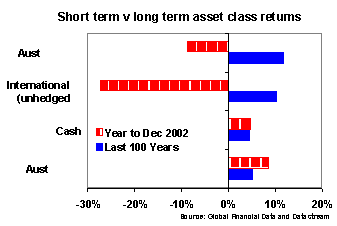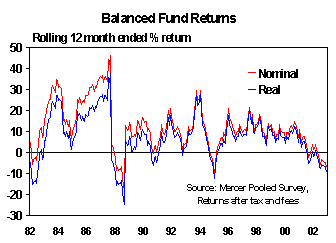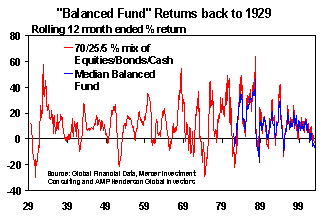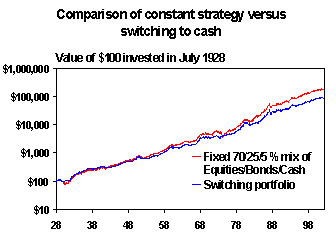Putting 2002 in context
After another tough six months in equity markets, most diversified superannuation funds ended 2002 with a fall in value. Shane Oliver, Chief Economist and Head of Investment Strategy – Asia Pacific for AMP Henderson Global Investors puts 2002 in context.
Monday, January 20th 2003, 1:29PM
After another tough six months in equity markets, most diversified superannuation funds ended 2002 with a fall in value. The median return for the year for balanced and growth funds in a recent Mercer Investment Consulting survey was negative 7.3 per cent. No one likes to see his or her capital go backwards. Naturally there is a tendency to wonder whether the funds would be better placed in an alternative area going forward (say in cash or housing).
Given these concerns, it is worth revisiting some of the points we made in July last year after negative returns were reported for the financial year.
Several points are worth noting.
1/ The key driver of returns for an investment fund is the asset classes in which the funds are invested. The most common superannuation funds have 60-70 per cent of their funds invested in equities (both in New Zealand and offshore). This is because over the long-term equities provide higher returns than other asset classes.

This does mean though that equity markets are the key drivers of performance for such funds. The problem over the past year has been that global equity markets delivered a negative 27.4 per cent return, Australia negative 8.8 per cent and the NZSE40 a barely positive 0.88 per cent. The generally positive return on other asset classes was not enough to offset these very poor equity returns.
2/ The historical record suggests that balanced funds have negative returns every seven years or so.The next chart shows rolling 12 month-ended returns for the median manager in the Mercer Investment Consulting balanced funds survey.

Negative returns, ie capital losses, occurred in the early 1980s, after the 1987 crash, in 1994 (due to falls in both the equity & bond markets) and more recently. Equity market falls were a key driver in each of these episodes. In real terms, ie after subtracting inflation, the loss over the last year or so is quite minor compared to the negative real returns experienced in 1982 and 1987-88.
3/ To provide a longer-term guide (as balanced funds only came into existence in the 1970s), the next chart is constructed on the basis that an investor invests 70 per cent in Australasian equities and 25 per cent in Australasian bonds and 5 per cent in bank bills (ie, cash). The chart only goes back to 1929 because we do not have a monthly time series for bank bill returns prior to July 1928. It also excludes exposure to global assets because again we do not have a long term monthly time series for aggregated global equities and bonds and in any case investment in international assets was limited prior to the 1980s. For comparison, returns for balanced funds in the Mercer Investment Consulting survey since 1982 are shown on the same chart.

This series would be more volatile than a typical balanced fund of today given the limited number of asset classes and the absence of property, all of which results in less diversification. However, once again it clearly suggests that a period of negative returns every few years seems to be a normal cyclical phenomenon and should not be seen as a reason for excessive alarm.
4/ To some degree the poor returns of the last few years reflects a payback for returns which were way above average during the 1990s. The following table provides a comparison:
|
|
Nominal
|
Real
|
|
1900-2001
70/25/5 % mix of
equities, bonds, cash respectively *
|
9.9
|
5.9
|
|
1900-2001
40/30/25/5 % mix of
equities, global equities, bonds, cash respectively *
|
9.4
|
5.4
|
|
Dec 1989- Dec 1999
median balanced &
growth fund, pre fees and taxes, Mercer Pooled Survey
|
12.5
|
10.3
|
In other words, the average balanced fund over the past 10 years experienced a gross real rate of return well above what may have reasonably been expected on the basis of asset class returns over the past century as a whole. Unfortunately, with equity markets we have to take the bad (high volatility and occasional negative returns) with the good (higher returns over the long-term than most other asset classes). In fact the former is the price we have to pay for the latter.
5/ After experiencing a loss it is always tempting to switch to a more conservative strategy. The following chart updates an analysis we undertook six months ago (except that we have moved to a calendar year decision rule). It shows the cumulative return to two portfolios since July 1928:
- a fixed balanced mix of 70 per cent equities, 25 per cent 10 year bonds and 5 per cent bank bills;
- a portfolio which starts off with the above mix but which moves 100 per cent into bank bills (ie cash) after any negative calendar year and doesn't move back until after the latter generates one calendar year of positive returns (on the assumption that an investor who switches to cash after a down year will require a year of positive returns to become confident again). We have assumed a 2-month information and decision-making lag. This is referred to as the “switching portfolio” in the chart.

The switching strategy does produce better results in the early 1930s and mid 1970s when there were two consecutive years of negative calendar year returns from the balanced mix (ie 1929 & 1930 and 1973 & 1974). However, over the long run it produces an average return of 9.5 per cent pa. versus 10.6 per cent pa for the balanced fund. (This compares to returns of 5.3 per cent pa for cash, 7.1 per cent pa for bonds and 11.7 per cent pa for equities.) On a $100 investment in July 1928 the switching portfolio would have grown to $86,902 by December 2002 compared to $175,178 for the constant balanced mix. The conclusion is obvious – switching to cash after a bad year is not the solution.
6/ Over the period from 1929 to 2001 the constant balanced mix outlined above had 14 negative return calendar years of which four were consecutive. This suggests that on the basis of historical data alone the probability of having a negative return this year is around 30 per cent (4 divided by 14). Of course this makes no allowance for other factors such as the magnitude of falls so far and other external events, all of which can impact the outcome. While 30 per cent might seem high it still leaves a strong probability of a positive return this year and it should also be noted that the average return in the year after a negative return year (or years) is 21.7 per cent.
Conclusion
In this note we have avoided any attempt at forecasting, focusing by contrast on the very long-term record. Key conclusions are that:
1. Investors should not get too alarmed by the negative balanced fund returns of the past year or so - a period of negative returns every few years is a normal cyclical phenomenon for balanced growth funds;
2. Responding to negative returns by switching either temporarily or permanently to cash would have produced lower returns over the long term;
3. The experience of the past year or so highlights the benefits of diversification – with returns for balanced funds hit only marginally compared to losses in equity markets;
The best approach is to adopt an appropriate long-term investment strategy and stick to it. The key is not to be thrown around by unexpected events or calamities which result in short term volatility.
Shane Oliver
Chief Economist and Head of Investment Strategy – Asia Pacific
AMP Henderson Global Investors
Commenting is closed














